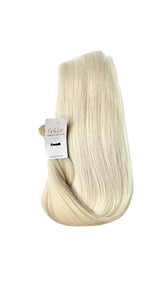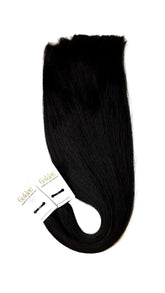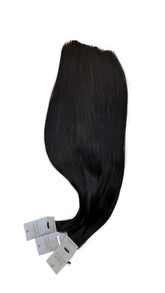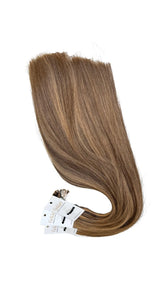Difference Between Synthetic Hair and Human Hair Extensions
by
Evelina Nausedaite
11 Apr 2025
DIFFERENCE BETWEEN SYNTHETIC HAIR AND HUMAN HAIR
When examining the fundamental differences between human hair and synthetic hair, particularly in the context of natural hair extensions, several key aspects emerge. Human hair extensions are celebrated for their authentic look and feel. They blend effortlessly with your natural hair, providing a seamless finish that synthetic options often struggle to achieve. Additionally, human hair extensions offer exceptional versatility in styling; they can be colored, cut, heat-styled, and treated just like your own hair, allowing for extensive customization. This level of adaptability makes human hair extensions a favored choice for those in search of a long-term, personalized hair solution. However, this natural quality typically comes with a higher price tag and requires more maintenance—akin to caring for natural hair, which includes regular washing and conditioning. Conversely, synthetic hair extensions serve as a more budget-friendly and low-maintenance alternative. The primary distinction lies in the materials used; synthetic extensions are usually made from a blend of plastic and synthetic fibers, crafted to resemble human hair. While advancements in technology have significantly improved the texture and appearance of synthetic hair, making it more lifelike than ever before, it still falls short of the authenticity found in real human hair. Synthetic extensions come pre-styled, effortlessly retaining their shape and color over time with minimal upkeep, which is a considerable advantage for those seeking convenience. However, they are generally less durable and versatile regarding styling, as exposure to high temperatures from styling tools can damage the synthetic fibers. This makes synthetic hair extensions ideal for temporary or occasional use or for individuals who prefer a consistent style without the need for frequent adjustments. ### Impact of Styling and Usage: Human Hair vs. Synthetic Hair **Styling Tools:** Excessive heat styling is a significant contributor to damage in human hair products, particularly with Relaxed Straight Hair Extensions. High temperatures can weaken the strands, leading to breakage and split ends. To protect the integrity of human hair, it’s essential to use heat-protectant products and select lower temperature settings while styling. Whenever possible, opting for natural drying and styling methods is advisable to maintain the health of the hair. **Color Treatments:** Human hair allows for dyeing versatility, but repeated color treatments can weaken the hair shafts and diminish their lifespan. Following detailed guides on how to apply hair color, seeking professional coloring services, and limiting the frequency of dye jobs can help preserve the hair’s integrity. ### Storage and Handling: Human Hair vs. Synthetic Hair A crucial but often overlooked aspect of ensuring the durability and longevity of human hair products is proper storage when not in use. The lifespan of human hair is not solely determined by its quality and maintenance but is also significantly affected by how it’s stored. ### Ideal Storage Conditions: Human Hair vs. Synthetic Hair 100% human hair products should be kept in a dry, cool environment. Excess moisture can lead to mildew or mold, damaging the hair. A cooler environment prevents drying out or brittleness, which can occur in excessively warm conditions. Direct sunlight can be harmful to human hair products. Prolonged exposure to the sun can fade the hair color and weaken the strands, leading to dryness and a loss of natural luster. Proper care and attention to storage conditions can significantly enhance the longevity and beauty of both human and synthetic hair extensions, ensuring they continue to look their best for as long as possible.
CAN YOU TELL THE DIFFERENCE BETWEEN SYNTHETIC HAIR AND HUMAN HAIR?
When selecting hair extensions, a frequently asked question is whether you can distinguish between synthetic hair and human hair. Additionally, many wonder how to differentiate between human hair and hair blends. Understanding the distinct characteristics and advantages of each type is essential for making an informed choice. In this article, we will delve into these differences to guide your decision-making process. ### Texture and Appearance The most apparent difference lies in the texture and appearance. Human hair extensions boast a natural feel and can blend effortlessly with your own hair, providing a seamless look. They can be styled, colored, and treated just like natural hair. In contrast, synthetic hair often exhibits a more artificial shine and texture, making it easier to identify as non-natural. ### Styling Flexibility **Human Hair: Versatile Styling** Human hair extensions offer exceptional styling flexibility. You can safely use heat tools such as curling irons and straighteners without worrying about damaging the extensions. This versatility allows you to create a wide range of hairstyles, from sleek and straight to bouncy curls, without any hassle. **Synthetic Hair: Limited by Heat Sensitivity** On the flip side, synthetic hair is generally more sensitive to heat. High temperatures can damage or even melt the fibers. Although there are heat-friendly synthetic options available, they still do not provide the same level of styling versatility as human hair extensions. ### Longevity and Maintenance **Human Hair: Long-Lasting with Proper Care** Human hair extensions, such as Straight Virgin Curly Hair, typically have a longer lifespan than synthetic alternatives, especially when cared for properly. With appropriate maintenance, they can withstand daily wear and tear, making them a durable and worthwhile investment. **Synthetic Hair: Low Maintenance but Shorter Lifespan** Synthetic hair extensions are known for their low-maintenance nature, retaining their style even after washing. However, they usually have a shorter lifespan and may require more frequent replacement compared to human hair extensions. By understanding these key differences—texture, styling flexibility, and longevity—you can make a more informed decision when selecting hair extensions that best suit your needs and lifestyle.
HOW TO DIFFERENTIATE BETWEEN HUMAN HAIR AND HUMAN HAIR BLEND
Understanding how to distinguish between 100% human hair and human hair blends is essential for anyone considering hair extensions. This knowledge not only aids in making an informed purchase but also ensures that you can properly care for and maintain your extensions. ### Look and Feel The most obvious difference lies in the look and feel of the hair. **100% Real Virgin Hair** has a natural appearance and a soft, luxurious texture that allows it to blend seamlessly with your own hair, providing a realistic look. In contrast, **human hair blends**, which combine real human hair with synthetic fibers, often exhibit a glossier finish and a less natural feel. This can make it easier to differentiate between the two types upon close inspection. ### Heat Resistance Another crucial factor to consider is heat resistance. **Human hair** can handle heat styling tools such as curling irons and straighteners, just like your natural hair, enabling you to style it freely without worry. However, **human hair blends** may not be as heat-resistant. High temperatures can cause damage to the synthetic fibers, leading to issues like melting or an unnatural stiffness in the hair. ### Color Test The color test serves as an effective method for differentiation. When dyed, **human hair** takes color changes more naturally and uniformly, allowing for a vibrant and consistent result. On the other hand, **human hair blends** may react differently to coloring, often resulting in uneven hues or failing to take the dye at all due to the presence of synthetic fibers. This can impact the overall look and longevity of your color treatment. ### Water Absorption Water absorption is another key factor to consider. **Pure human hair**, such as **Textured Straight Hair**, absorbs water and moisture similarly to natural hair, making it heavier when wet. In contrast, a **human hair blend** tends to repel water, leading to a lighter feel and quicker drying time. This difference can affect how the extensions behave in different environments, especially when exposed to humidity or moisture. ### Price Point Finally, the price is a significant indicator when determining the type of hair. **Pure human hair** is generally more expensive due to its superior quality, durability, and the extensive processing required to maintain its natural characteristics. Conversely, **human hair blends** are typically more affordable, reflecting their mixed composition. When comparing options, a noticeable price difference can often indicate the type of hair you are considering. By being aware of these distinguishing features—look and feel, heat resistance, color response, water absorption, and price—you can make an educated decision when selecting hair extensions. This understanding will not only lead to a more satisfying purchase but will also enhance your ability to care for your extensions effectively, ensuring they remain beautiful and functional for as long as possible.
DOES HUMAN HAIR LAST LONGER THAN SYNTHETIC?
When it comes to choosing between human hair and synthetic extensions, one of the most pressing questions is: **Does human hair last longer than synthetic?** Understanding the differences in durability and maintenance can significantly influence your investment in hair extensions. ### The Durability Factor **Human Hair Extensions** Human hair extensions are widely recognized for their exceptional durability. Crafted from 100% real human hair, they can withstand various styling methods, washing routines, and the rigors of daily wear far better than synthetic alternatives. With appropriate care, human hair extensions can last anywhere from one to three years, or even longer. The key to their longevity lies in routine maintenance that mirrors the care required for natural hair, which includes gentle washing, conditioning, and mindful styling practices. **Synthetic Hair Extensions** In contrast, synthetic hair extensions, made from fine plastic fibers, typically have a shorter lifespan. Depending on the quality of the fibers and how frequently they are used, synthetic extensions usually last a few months. While advancements in technology have enhanced the quality and appearance of synthetic hair, they still fall short in durability compared to human hair. Frequent heat styling, exposure to environmental factors, and general wear and tear can quickly degrade synthetic fibers, resulting in a less natural appearance over time. ### Styling and Maintenance Both human and synthetic hair extensions require maintenance, but the methods and level of care differ significantly. **Human Hair: Versatile Styling and Maintenance** Human hair extensions, such as **Best Silky Straight Virgin Hair**, offer remarkable versatility. You can style them using heat tools, dye them, and treat them just like your own hair, allowing for a wide range of looks and customization. This adaptability makes human hair extensions a preferred choice for those who desire a more authentic appearance and the freedom to change their style as they wish. However, they do require regular maintenance to keep them looking their best, including washing, conditioning, and protecting them from heat damage. **Synthetic Hair: Limited Styling Options** On the other hand, synthetic hair extensions often have limitations when it comes to styling. While they can be easier to maintain in terms of initial upkeep, they are less responsive to heat styling and may not hold up well under the same treatment as human hair. Additionally, synthetic fibers may not react well to various hair products, which can make it challenging to achieve a natural look. Although synthetic extensions are generally more affordable, the quality and versatility of high-grade human hair, like **Best Silky Straight Virgin Hair**, often make it the optimal choice for individuals seeking a more genuine and customizable look. ### Conclusion In summary, if you're weighing the options between human hair and synthetic extensions, the durability and styling flexibility of human hair make it a superior choice for long-term wear. While synthetic hair offers a budget-friendly and low-maintenance alternative, its shorter lifespan and limitations in styling may not meet the needs of those looking for versatility and a natural look. Ultimately, your decision may hinge on your budget, styling preferences, and how much time you’re willing to invest in maintenance.
WHAT ADVANTAGE DOES HUMAN HAIR HAVE OVER SYNTHETIC HAIR?
When it comes to enhancing your appearance with black hair extensions, understanding the differences between synthetic and human hair is crucial for making the best choice. ### Authentic Appearance and Texture **Natural Look:** The standout advantage of human hair extensions is their authentic look and texture. They blend seamlessly with your natural hair, offering a result that is virtually indistinguishable from your own. This natural integration is essential for anyone aiming for an undetectable enhancement, especially when wearing black hair extensions. **Texture Variety:** Human hair extensions come in a diverse range of textures, making it easier to find a match for your natural hair type. Whether your hair is straight, wavy, or curly, you can find human hair extensions that align perfectly with your own locks, ensuring a cohesive and flattering look. ### Styling Flexibility **Heat Styling:** One of the significant benefits of real human hair extensions is their ability to withstand heat styling. You can use tools like curling irons and straighteners without the risk of damaging the hair. This flexibility is particularly advantageous for those who enjoy frequently changing their hairstyles, allowing for a variety of looks without compromising the integrity of the extensions. **Color Customization:** Another key benefit is the ability to dye human hair extensions. You can easily color them to match your natural hair perfectly or experiment with different hues to achieve your desired look. This level of customization is not advisable with synthetic hair, as the synthetic fibers may not react well to dye and could become damaged in the process. ### Benefits and Considerations **Affordability and Variety:** One of the primary advantages of synthetic hair is its affordability compared to human hair. Synthetic extensions are generally less expensive, making them accessible for those on a budget. Additionally, synthetic hair is available in a wide array of styles and colors, offering flexibility for various fashion choices and preferences. **Limitations in Styling:** While modern synthetic hair is more heat-resistant than earlier versions, it still has limitations regarding styling with heat tools. High temperatures can damage synthetic fibers, leading to melting or an unnatural appearance. Understanding these constraints is essential for maintaining the quality and longevity of synthetic hair products. Therefore, if you frequently style your hair with heat, human hair extensions may be the more suitable choice. ### Conclusion In summary, for those looking to enhance their appearance with black hair extensions, human hair offers an authentic appearance, texture variety, and superior styling flexibility. While synthetic hair provides an affordable option with a wide range of styles, it does come with limitations in terms of styling and customization. Ultimately, your choice should reflect your personal preferences, budget, and how you intend to use the extensions, ensuring you achieve the look you desire while maintaining the health of your hair.
THE DOWNSIDES OF SYNTHETIC HAIR: WHAT ARE THE 4 DISADVANTAGES OF SYNTHETIC HAIR?
When considering hair extensions, evaluating the limitations and advantages of synthetic hair compared to human hair is essential for making an informed decision. Here’s a closer look at some of the key drawbacks of synthetic hair: ### Limited Styling Options One of the most significant limitations of synthetic hair is its inability to withstand high temperatures. Unlike human hair, which can tolerate heat from styling tools like curling irons, straighteners, and blow dryers, synthetic strands can melt or become irreparably damaged when exposed to heat. This restriction means that wearers of synthetic hair extensions or wigs often find themselves unable to experiment with various heat-styled looks, making it a less versatile option than human hair. ### Unnatural Appearance Although synthetic hair has improved in its ability to mimic the look of natural hair, it often lacks realism. A common issue with some synthetic products is an unnatural sheen, which can stand out against the natural matte finish of human hair. This difference in luster can make synthetic extensions or wigs appear more artificial, lacking the seamless, natural integration that human hair extensions provide. ### Reduced Longevity The lifespan of synthetic hair is generally shorter than that of human hair. Since synthetic fibers are plastic-based, they are more susceptible to damage and wear over time. They can become tangled, frizzy, or lose their initial texture and color more quickly than human hair. Consequently, synthetic hair products may require more frequent replacements, potentially leading to increased long-term costs and inconvenience for the wearer. ### Less Breathability Breathability is a crucial factor in the comfort of hairpieces, particularly in warm climates or during physical activities. Synthetic wigs often offer less breathability compared to those made from human hair. The cap construction and the nature of synthetic fibers can trap heat and moisture against the scalp, leading to discomfort or irritation. In contrast, human hair wigs tend to be more breathable, allowing for better air circulation and providing a more comfortable experience for the wearer. ### Conclusion Ultimately, choosing between human hair and synthetic hair extensions comes down to individual needs, preferences, and budget. Human hair offers a natural appearance, versatility in styling, and greater longevity, making it an appealing option for those seeking high-quality extensions. However, synthetic hair provides a more affordable alternative with varying levels of quality and realism, suitable for those who may not require as much versatility or durability. By understanding the key differences, advantages, and disadvantages of each type, you can make an informed choice that best fits your lifestyle and hair care routine. Regardless of your selection, proper care and maintenance are essential for extending the lifespan and maintaining the look of both human and synthetic hair extensions.









